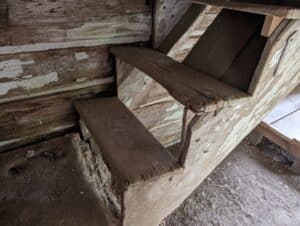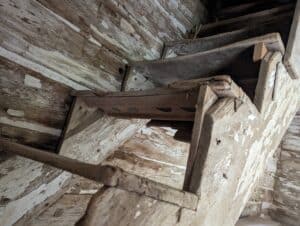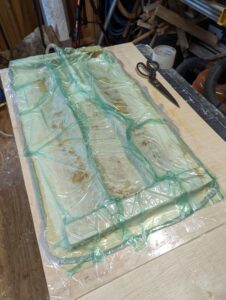Slave Dwelling Preservation Update from Fall 2023

If you have been on site lately, you may have spotted our team making repairs to the Slave Dwelling. Recently, we have repaired the sash of a window, cleaned the roof, and repaired the second tread on a stair. These repairs were made possible because of the African American Heritage Preservation Program Grant from the State of Maryland.
The windows in the Slave Dwelling are believed to date back to around 1910 so restoring them is a complex task involving documentation of issues, removal of loose failing paint, disassembly of sash and re-glazing. During the documentation phase, we discovered that where the muntins entered the bottom rail, the mortises were rotten. Repairing the mortises would have done as much damage to the sash as full replacement. Wood repairs were done with southern yellow, heart pine. This wood is of greater quality than the existing sash and will give better rot resistance.
To retain the beautiful wavy characteristic of the glass lenses in the sashes, Hx-Tal epoxy was used to “mend” these lenses. While the cracks are still visible, the lenses are now solid. The reassembled sash were joined with heart pine dowels instead of the metal pins that were removed. Before returning the glass to the sash, all wood was dressed with a mixture of boiled linseed oil and turpentine which acts as a preservative for the wood and hydrates the wood. Brouns and Co. linseed oil paint was chosen for the finish as it approximates what could have been used at the time without the lead.
The Slave Dwelling roof, which was replaced in 2008, received its first clean in over five years to remove built up dirt and lichen growth on the edge of the shingles. Typically, western red cedar shingles are expected to last 20-25 years. Unfortunately, the lichen growth has hastened deterioration leaving these shingles with approximately 5 more years of life if well maintained. Cleaning of the roof should occur again in less than five years.
Finally, the second tread on a stair in the Slave Dwelling had split from end to end which was painstakingly repaired by using a composite. This allowed our team to reinforce the thread without replacing any parts.
There are still many repairs to be done. The interior and exterior painting are next on the list of preservation efforts.


[This article was included in the Fall 2023 Newsletter]
